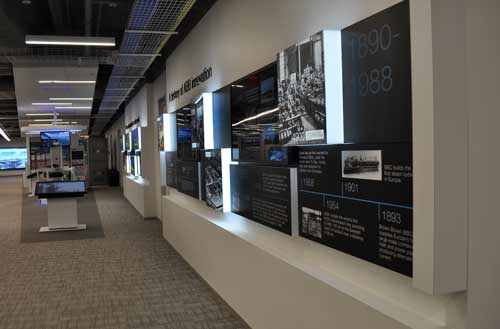What can interactive digital signage do?
Interactive digital signage is a creative medium, giving marketers and their clients plenty of latitude in creating compelling content. Part of this creativity has to do with the images, videos and audio the marketer uses to attract attention. Interactive digital signage also offers an interesting mix of functionality for reaching customers and visitors, and here are some examples:• Direct – Interactive signage can be placed at the entrance of a venue, department store or professional building, and used to help people navigate through the space. For example, a set of interactive kiosks at a sports arena can be used to help people find their seats, concessions or restroom areas. Pair these interactive displays with a code scanner, and fans can scan their tickets to get this information, without tapping through a series of menus. It’s efficient, convenient and engaging.
Interactive signage is also a smart addition to a department or clothing store. Customers can walk up to the display, browse through product offerings or specials, select something that interests them and get directions on where to go. You could do the same with car lots, office directories, furniture stores and anywhere someone is likely to be confused or frustrated walking around. Let the interactive signage take care of that problem.
• Inform – Interactive digital signage can influence consumer behavior through standard, attention-capturing means, or it can be used to give consumers the information they need to make a purchase. For example, a car dealership could place interactive signage on its showroom floor, next to each vehicle display. Prospective car buyers can walk up to these displays and customize their vehicle trim, color and other features.
Interactive signage can be used to compare products, inspire consumers with a new product idea or convince people to make a purchase based on available data or specials. It can also be used to run product videos, which can instruct consumers how to use the product better, or just wow them with an impressive piece of media.
• Entertain – Interactive digital signage can be used with more than just a touchscreen—it can be interfaced with using texts, QR codes or strategically-placed sensors that fire when someone walks by the display.
These additional delivery methods give marketers room in crafting a memorable, fun experience. For example, interactive signage can be used to carousel through a series of social media posts or photos. Consumers can use their smartphone to drop a social media post with the appropriate hashtag, or text a number directly with a keyword. In either case, consumers may see their post or photo displayed on the signage, which is always a thrill.
Interactive digital signage can be used to distract people standing in line or give people something to play with while they are shopping. There are hundreds of possibilities here, ranging from open-ended whiteboards to capturing video of the user and running it through a filter for amusing results.
Interactive digital signage is versatile in function and it’s versatile in the form it can take. Standard commercial displays are the typical go-to option, as they can be placed and arranged in a myriad of ways. However, organizations can go bigger with their interactive signage initiatives. For instance, a series of displays installed in the floor can track a user’s footsteps or create a path out of graphics for people to follow. Or, consider a video wall, which can be scaled up to impressive heights and expand what marketers can do with their content visually. In the hands of a creative marketer or team, interactive digital signage can craft the kind of experience that people will remember and associate with the brand in a positive way. You don’t have to be a world-class artist or videographer to make an impact with interactive signage. With its novelty and versatility, any business or organization can improve how they communicate and market with the technology.


